The term 'cartilage' refers to a strong, elastic connective tissue. The human body has three kinds of cartilage called hyaline, elastic, and fibrocartilage. Buzzle provides information that will help you to understand the types of cartilage in the human body.
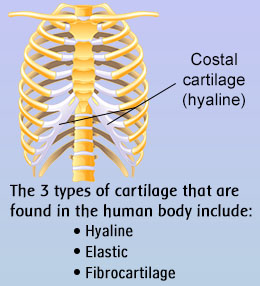
Did You Know?The hyaline cartilage forms most of the embryonic skeleton. It is after birth that the cartilage is replaced with bone tissue.The term 'connective tissue' refers to a type of tissue that provides a supportive framework for the tissues and the organs of the body. The properties of the tissue are determined by the type of cells it contains, the number and arrangement of fibers, and the properties of the ground substance (liquid portion) of the extracellular matrix, which is the space between the cells. Cartilage is a type of connective tissue that is formed by cells called chondrocytes. These cells could occur singly or in groups within lacunae, which are spaces within the matrix. Perichondrium refers to the membrane of dense, irregular connective tissue that surrounds the surface of most of the cartilage in the human body. It must be noted that the perichondrium is the only part of the cartilage where blood vessels and nerves can be found.Even after the process of production of cartilage by chondrocytes is complete, the chondrocytes stay within the tissue. Then, these are referred to as chondroblasts. In case of cartilage, the ground substance is a gelatinous material called chondroitin sulfate. Collagen and elastin are the protein fibers that are embedded within chondroin sulfate. The matrix that is formed by them is tough, as well as flexible. While the fibers in the matrix play a role in the retention of the shape and the tensile strength, the hydrated, viscous material of the matrix protects the surrounding structures from compression forces.
Most connective tissues have a rich supply of blood, with the exception of cartilage. The delivery of nutrients through blood is extremely essential for quick recovery. Due to the minimal or limited blood supply, cartilage injuries in adults take a much longer time to heal.Types of Cartilage in the Human BodyThree types of cartilages are found in the human body. These include:
➠ Hyaline
➠ Elastic
➠ Fibrocartilage
These three types differ in terms of their elasticity, structure, tensile strength, etc. While the hyaline cartilage contains type II collagen fibers that are widely dispersed, the elastic cartilage contains many elastic fibers. Fibrocartilage is toughest amongst them and is densely packed with collagen fibers.
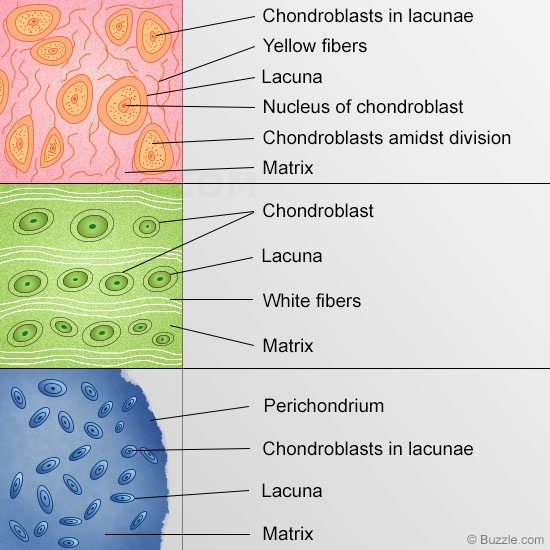 Elastic cartilage, Fibrocartilage, and Hyaline cartilage (From top to bottom)
Elastic cartilage, Fibrocartilage, and Hyaline cartilage (From top to bottom)
Hyaline CartilageHyaline cartilage is the most common type of cartilage. It has a pearly-bluish color. Though it is tough and firm, it is elastic as well. It can be found at many places including:
➠Nose
➠Just below the thyroid cartilage, as a ring-shaped piece of hyaline cartilage called the cricoid cartilage
➠At places where the ribs attach to the sternum (as costal cartilage)
➠In the trachea (as rings of the trachea, arytenoid cartilage (a pair of pyramidal-shaped cartilage that anchor and help move the true vocal cords), cuneiform cartilage, corniculate cartilage)
➠ In the primary bronchi as cartilage rings
➠In the secondary bronchi as irregular plates of cartilage
➠Between the joints such as knees, hips, shoulder, etc., as articular cartilage
Articular cartilage covers the surface of the ends of bones. It acts as a shock-absorber. For instance, the cartilage in the knees helps transmit the load when we run, bend, stretch, or perform any physical activity. The outer layer of the cartilage is referred to as the gliding zone. One of the main functions of this type of cartilage is to enable the bones in the joints to move and glide over each other without friction. On account of being avascular (lacking blood supply), articular cartilage can get damaged due to the normal wear and tear that occurs with age or an injury. The degeneration of the cartilage in old age gives rise to the degenerative joint condition called osteoarthritis.Elastic CartilageAlso referred to as the yellow cartilage, this cartilage is quite springy due to the presence of many irregular networks of elastin protein fibers in the matrix. The elastin fibers present in it are responsible for its ability to spring back into shape immediately after being deformed. It resembles the hyaline cartilage to some extent.
It has chondrocytes surrounded with a thin collagenous network of cartilage-extracellular matrix, and the dense networks of elastic fibers are found between these regions. The differentiating factor between the two types of cartilage is the presence of elastin fibers that are embedded in the ground substance. Perichondrium is also found around this type of cartilage. It helps in forming and maintaining the shape of certain structures of the body. It is a supportive, elastic tissue that provides firmness and flexibility. It can be found at the following places:
➠Pinna or the cartilaginous structure in the external ears
➠Pharyngotympanic (Eustachian) tubes
➠Parts of the nose
➠Parts of the larynx
➠Parts of the epiglottis, which is the flap that covers the opening of the larynx during swallowingFibrocartilageThe toughest type of cartilage, fibrocartilage is sometimes referred to as white cartilage. It has the ability to withstand heavy weights. The defining feature when it comes to the histology is that it contains fine collagen fibers scattered in a rows or layers, but with gaps between the lacunae and the bundles of collagen fibers. The number of chondrocytes is quite less, and the cells are embedded in the matrix material between the fibers, and not on the fibers. Fibrocartilage contains both type I and type II collagen. This cartilage is very effective as a shock-absorber due to its ability to resist compression forces. It provides support to the surrounding structures that are attached to it. It is found at the following places in the human body:
➠In the intervertebral discs in the spine
➠Menisci in the knees
➠Pubic symphysis, which is place where the hip bones join at the front of the bodyLocation of CartilageThese three types of cartilage are found at different places in the body. The places where this type of connective tissue is present include:
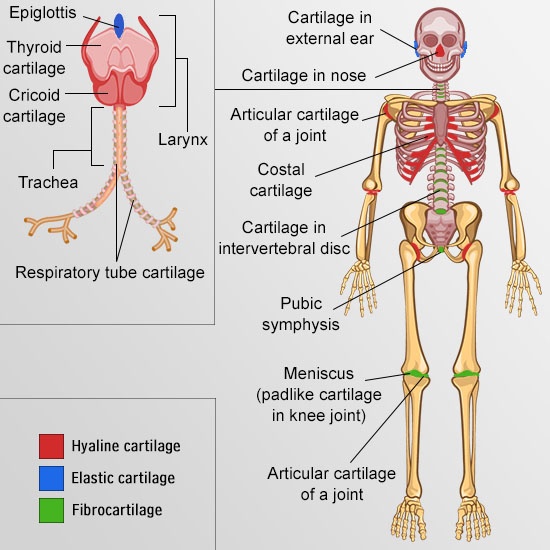
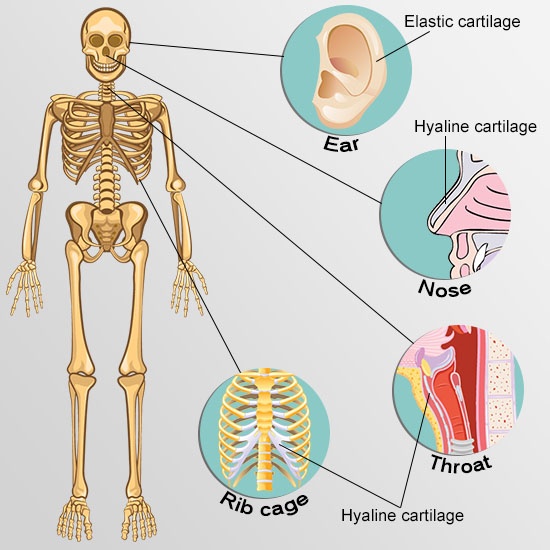
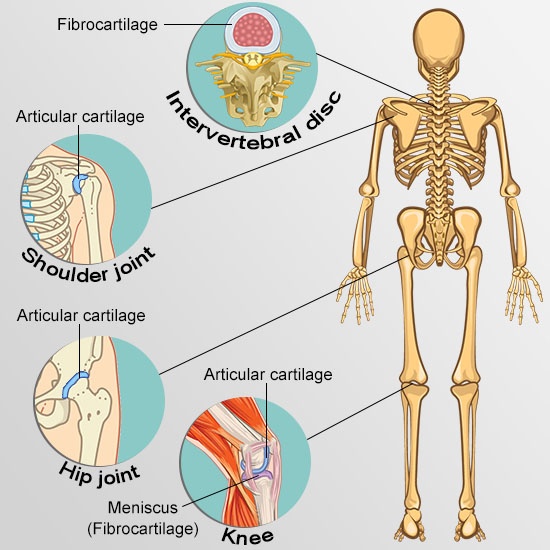
➠Nose
➠Ears
➠Trachea
➠Larynx
➠Smaller respiratory tubes
➠Articular surfaces of bones in synovial joints
➠Costal cartilages (rib cage)All the three types of cartilage present in the human body play an important role, especially the articular hyaline cartilage that ensures friction-free movement of the joints. The other two types are also important, as they act as a cushion for certain bones, provide support to the surrounding structures, and resist the compression forces. These can get damaged due to injuries or get worn down with age. Cauliflower ear, slipped disc, and osteoarthritis are examples of damage to the elastic cartilage, fibrocartilage, and hyaline cartilage, respectively. Since the cartilage doesn't have a blood supply, the rate of recovery is quite slow in case of cartilage injuries in adults. Thus, medical assistance must be sought at the earliest for proper treatment.


 Did You Know?The hyaline cartilage forms most of the embryonic skeleton. It is after birth that the cartilage is replaced with bone tissue.The term 'connective tissue' refers to a type of tissue that provides a supportive framework for the tissues and the organs of the body. The properties of the tissue are determined by the type of cells it contains, the number and arrangement of fibers, and the properties of the ground substance (liquid portion) of the extracellular matrix, which is the space between the cells. Cartilage is a type of connective tissue that is formed by cells called chondrocytes. These cells could occur singly or in groups within lacunae, which are spaces within the matrix. Perichondrium refers to the membrane of dense, irregular connective tissue that surrounds the surface of most of the cartilage in the human body. It must be noted that the perichondrium is the only part of the cartilage where blood vessels and nerves can be found.Even after the process of production of cartilage by chondrocytes is complete, the chondrocytes stay within the tissue. Then, these are referred to as chondroblasts. In case of cartilage, the ground substance is a gelatinous material called chondroitin sulfate. Collagen and elastin are the protein fibers that are embedded within chondroin sulfate. The matrix that is formed by them is tough, as well as flexible. While the fibers in the matrix play a role in the retention of the shape and the tensile strength, the hydrated, viscous material of the matrix protects the surrounding structures from compression forces.
Did You Know?The hyaline cartilage forms most of the embryonic skeleton. It is after birth that the cartilage is replaced with bone tissue.The term 'connective tissue' refers to a type of tissue that provides a supportive framework for the tissues and the organs of the body. The properties of the tissue are determined by the type of cells it contains, the number and arrangement of fibers, and the properties of the ground substance (liquid portion) of the extracellular matrix, which is the space between the cells. Cartilage is a type of connective tissue that is formed by cells called chondrocytes. These cells could occur singly or in groups within lacunae, which are spaces within the matrix. Perichondrium refers to the membrane of dense, irregular connective tissue that surrounds the surface of most of the cartilage in the human body. It must be noted that the perichondrium is the only part of the cartilage where blood vessels and nerves can be found.Even after the process of production of cartilage by chondrocytes is complete, the chondrocytes stay within the tissue. Then, these are referred to as chondroblasts. In case of cartilage, the ground substance is a gelatinous material called chondroitin sulfate. Collagen and elastin are the protein fibers that are embedded within chondroin sulfate. The matrix that is formed by them is tough, as well as flexible. While the fibers in the matrix play a role in the retention of the shape and the tensile strength, the hydrated, viscous material of the matrix protects the surrounding structures from compression forces. Elastic cartilage, Fibrocartilage, and Hyaline cartilage (From top to bottom)
Elastic cartilage, Fibrocartilage, and Hyaline cartilage (From top to bottom)

 ➠Nose
➠Nose